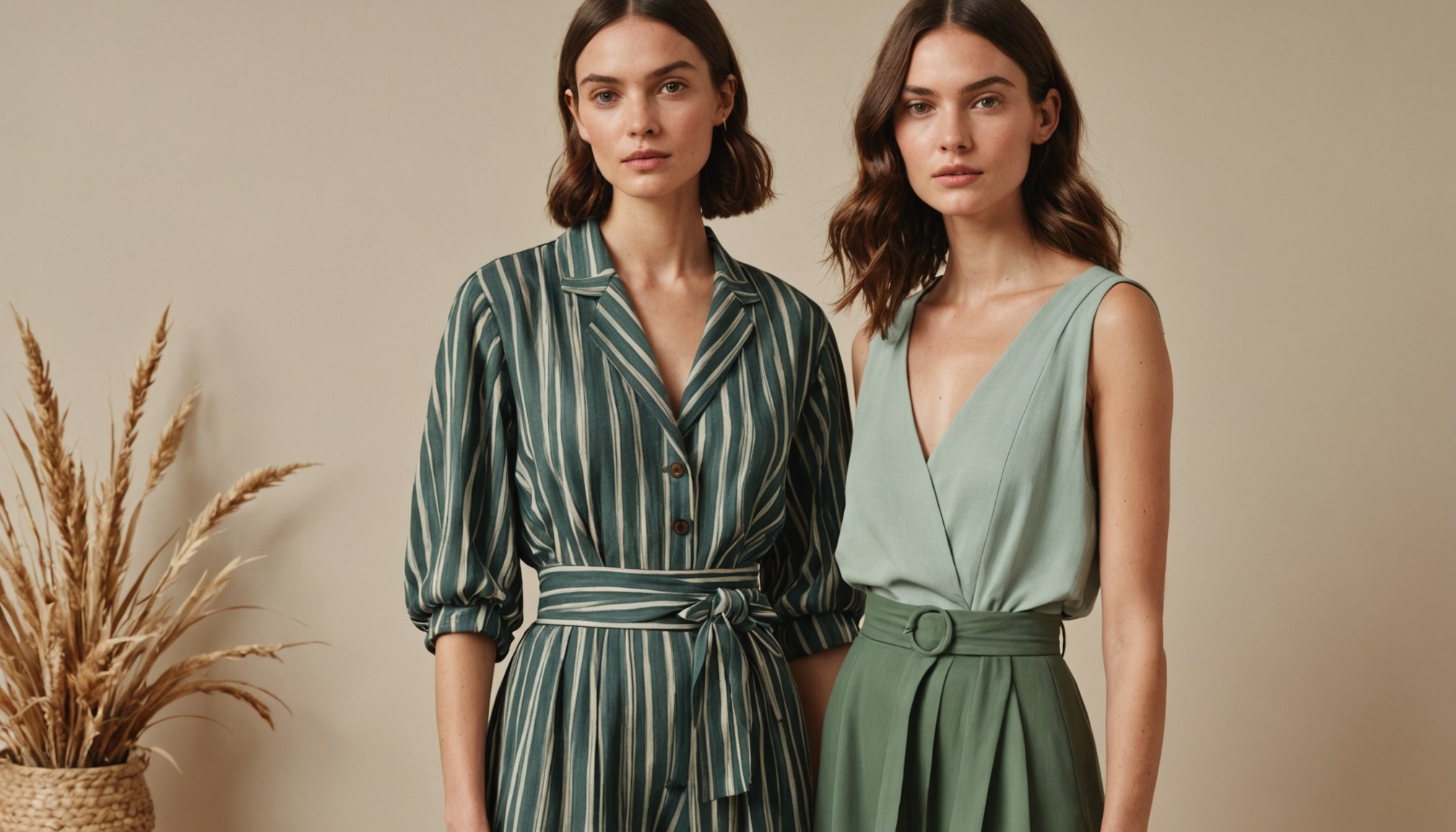Overview of Trendy Sustainable Fabrics
In recent years, sustainable fabrics have gained substantial importance in the fashion industry, acting as a catalyst for change towards environmentally friendly practices. These eco-friendly materials are designed to minimize environmental impact during their lifecycle, from production to disposal. The fashion world is seeing a shift where designers are increasingly opting for fabric innovations that are not only stylish but also environmentally responsible.
Definition and Importance
Sustainable fabrics are materials that are produced in a way that reduces harm to the planet, often through reduced water usage, fewer chemicals, and lower CO2 emissions. Their importance lies in addressing the fashion industry’s significant environmental footprint, promoting a shift towards a greener future.
Also to discover : Ultimate guide to building a sustainable capsule wardrobe for women in the uk: key elements for eco-friendly fashion
Current Trends
Designers are actively pursuing sustainable fabric choices, with innovations like organic cotton, hemp, and bamboo fibers leading the way. These materials offer unique properties such as being inherently durable, breathable, and biodegradable. Such trends signal a significant push towards eco-friendly collections that do not compromise on style.
Environmental Impacts
Switching to sustainable materials significantly lowers the environmental impacts associated with fashion production. This involves reducing pollution, conserving water, and enhancing the overall sustainability of ecosystems. Such changes not only benefit the environment but also pave the way for responsible consumerism.
Also read : Uncover london”s top destinations for creative fashion upcycling workshops!
Popular Sustainable Fabrics Among UK Designers
Recent UK fashion trends reveal a growing affinity for popular sustainable fabrics. Designers are embracing these materials not only for their environmental benefits but also for their unique textures and versatility. Here are some favourites among UK creators:
Organic Cotton
Organic cotton is often preferred due to its minimal use of harmful pesticides and water-efficient growing techniques. Designers are drawn to its softness and breathability, making it a staple in eco-friendly collections. Many UK designers prominently include organic cotton in their collections, showcasing its benefits over conventional cotton in terms of sustainability and style. This choice reflects a commitment to reducing environmental impact while maintaining high-quality standards.
Tencel (Lyocell)
Tencel, a fabric derived from sustainably sourced wood pulp, shines for its production process, which uses a closed-loop system to minimise waste. UK designers appreciate Tencel for its smooth texture and strength, finding it suitable for a wide range of garments. Notable designers incorporate Tencel into their lines, reflecting its rising status as a sustainable fashion choice.
Hemp
Valued for its versatility and durability, hemp is another top choice in the UK fashion scene. Its properties make it a robust feature for everything from casual wear to sophisticated attire. Fashion brands within the UK have integrated hemp into their collections, demonstrating its adaptability and alignment with sustainable principles.
Stylish UK Designers Utilizing Sustainable Fabrics
The sustainable fashion movement in the UK has seen an impressive rise, driven by designers committed to eco-friendly collections. These designers are not only responding to global calls for sustainability but are also setting trends that inspire the fashion industry worldwide.
Designer Spotlight: Stella McCartney
Stella McCartney stands as a prominent figure in the UK fashion scene, renowned for her rigorous dedication to sustainable fashion. Her commitment is evident in her choice of materials, ensuring minimal environmental impact. Key collections include outfits crafted from recycled polyester and sustainable viscose, reflecting her innovative approach. Stella’s designs are not just eco-conscious but also exude style and sophistication, making her a pioneer in integrating sustainability with high fashion.
Designer Spotlight: Christopher Raeburn
Christopher Raeburn is celebrated for his unique take on sustainable fashion through upcycling. Raeburn’s approach contrasts with traditional practices, focusing on transforming discarded materials into fashion treasures. His collections often feature notable pieces like outerwear crafted from decommissioned parachutes, showcasing his creativity and commitment to environmental significance.
Designer Spotlight: Roksanda Ilincic
Roksanda Ilincic brings innovation to the forefront with her use of sustainable fabrics. Her collections are marked by bold colors and architectural shapes, marrying style with sustainability. Roksanda’s work not only advances fashion sustainability but also pushes the boundaries of what’s possible in eco-friendly design, influencing peers and consumers alike.
Environmental Benefits of Sustainable Fabrics
Embracing sustainable fabrics offers numerous environmental benefits, reinforcing their role in the sustainable fashion movement. One significant advantage is the marked reduction in water usage. Unlike conventional textile production, sustainable materials like hemp and Tencel are developed using methods that are significantly more water-efficient. This conservation is crucial as it directly impacts water scarcity issues globally.
Sustainable fabrics also boast a lower carbon footprint, helping to mitigate their impact on climate change. By prioritising eco-conscious choices, the fashion industry can reduce greenhouse gas emissions associated with production processes. Tencel, for example, is renowned for its environmentally friendly production, which minimizes CO2 emissions through a closed-loop system.
Furthermore, many sustainable fabrics are biodegradable, aiding in waste reduction. Materials such as organic cotton decompose more swiftly compared to synthetics, leading to less environmental pollution post-disposal. This biodegradability ensures that the fashion industry can move toward a more circular economy where waste is minimized.
Incorporating sustainable fabrics not only benefits the environment but also empowers consumers to make more environmentally conscious choices. Through these practices, fashion can play a pivotal role in promoting sustainability, influencing broader ecological change.
Visuals and Recent Collections
The visual representation of sustainable fashion collections plays a pivotal role in highlighting the eco-friendly strides within the industry. Designers are using captivating images and creative showcases to illustrate the beauty and practicality of eco-friendly materials.
Visuals act as a bridge, bringing the concept of sustainability to life. A well-crafted visual enhances the understanding of how sustainable fabrics integrate into everyday fashion. Designers utilize lookbooks and fashion shows to spotlight their collections, accentuating fabric innovations like Tencel, hemp, and organic cotton.
Recent collections underscore the significance of eco-friendly visuals in conveying a designer’s commitment to sustainability. These presentations highlight the aesthetic appeal and versatile applications of sustainable materials, drawing consumer interest and promoting informed fashion choices.
Through meticulously curated images and fashion shows, brands communicate their dedication to reducing environmental impacts. Such initiatives also serve as inspiration for the industry and consumers alike, encouraging others to explore sustainable alternatives.
Lookbooks and showcases serve as essential tools in demonstrating the marriage of sustainability and style, showing how environmentally conscious choices can transform into fashionable statements. This visual storytelling not only educates but actively engages audiences, bolstering the sustainable fashion movement.











